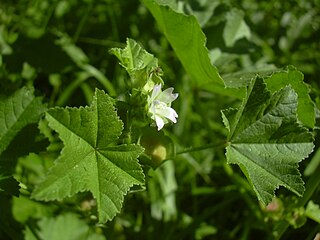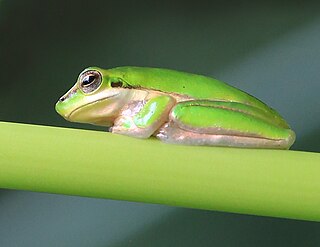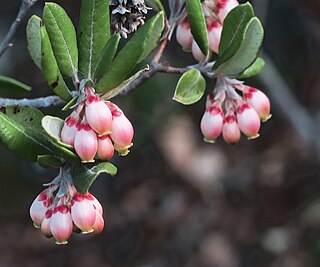
Sorghum or broomcorn is a genus of about 25 species of flowering plants in the grass family (Poaceae). Some of these species are grown as cereals for human consumption, in pastures for animals as fodder, and as bristles for brooms. Sorghum grain is a nutritious food rich in protein, dietary fiber, B vitamins, and minerals.

A bicolor cat is a cat with white fur combined with fur of some other color, for example solid black, tabby, or colorpointed. There are various patterns of bicolor cat. These range from the Van-patterned through to solid color with a throat locket or medallion. Bicolor coats are found in many cat breeds, as well as being common in domestic longhair and domestic shorthair cats.

Malvaceae, or the mallows, is a family of flowering plants estimated to contain 244 genera with 4225 known species. Well-known members of economic importance include okra, cotton, cacao, roselle and durian. There are also some genera containing familiar ornamentals, such as Alcea (hollyhock), Malva (mallow), and Tilia. The genera with the largest numbers of species include Hibiscus, Pavonia, Sida, Ayenia, Dombeya, and Sterculia.

The tree swallow is a migratory bird of the family Hirundinidae. Found in the Americas, the tree swallow was first described in 1807 by French ornithologist Louis Vieillot as Hirundo bicolor. It has since been moved to its current genus, Tachycineta, within which its phylogenetic placement is debated. The tree swallow has glossy blue-green upperparts, with the exception of the blackish wings and tail, and white underparts. The bill is black, the eyes dark brown, and the legs and feet pale brown. The female is generally duller than the male, and the first-year female has mostly brown upperparts, with some blue feathers. Juveniles have brown upperparts, and grey-brown-washed breasts. The tree swallow breeds in the US and Canada. It winters along southern US coasts south, along the Gulf Coast, to Panama and the northwestern coast of South America, and in the West Indies.

The pied tamarin, sometimes referred to as the Brazilian bare-faced tamarin, is a Critically Endangered primate species found in a restricted area of the Brazilian Amazon Rainforest. It was named the mascot of Manaus, Brazil in 2005. The species is endangered due to the increasing size of the city of Manaus which is encroaching on their native habitat.

The fulvous whistling duck or fulvous tree duck is a species of whistling duck that breeds across the world's tropical regions in much of Mexico and South America, the West Indies, the southern United States, sub-Saharan Africa and the Indian subcontinent. It has plumage that is mainly reddish brown, long legs and a long grey bill, and shows a distinctive white band across its black tail in flight. Like other members of its ancient lineage, it has a whistling call which is given in flight or on the ground. Its preferred habitat consists of wetlands with plentiful vegetation, including shallow lakes and paddy fields. The nest, built from plant material and unlined, is placed among dense vegetation or in a tree hole. The typical clutch is around ten whitish eggs. The breeding adults, which pair for life, take turns to incubate, and the eggs hatch in 24–29 days. The downy grey ducklings leave the nest within a day or so of hatching, but the parents continue to protect them until they fledge around nine weeks later.

Loxocemus bicolor, the sole member of the monotypic family Loxocemidae and commonly known as the Mexican python, Mexican burrowing python and Mexican burrowing snake, is a species of python-like snake found in Mexico and Central America. No subspecies are currently recognized. Analyses of DNA show that Loxocemus is most closely related to the true pythons and the sunbeam snakes.

The swamp wallaby is a small macropod marsupial of eastern Australia. This wallaby is also commonly known as the black wallaby, with other names including black-tailed wallaby, fern wallaby, black pademelon, stinker, and black stinker on account of its characteristic swampy odour.

Phyllobates is a genus of poison dart frogs native to Central and South America, from Nicaragua to Colombia. There are 3 different Colombian species of Phyllobates, considered highly toxic species due to the poison they contain in the wild.

Sorghum bicolor, commonly called sorghum and also known as great millet, broomcorn, guinea corn, durra, imphee, jowar, or milo, is a grass species cultivated for its grain, which is used for food for humans, animal feed, and ethanol production. Sorghum originated in Africa, and is now cultivated widely in tropical and subtropical regions. Sorghum is the world's fifth-most important cereal crop after rice, wheat, maize, and barley, with 61,000,000 metric tons of annual global production in 2021. S. bicolor is typically an annual, but some cultivars are perennial. It grows in clumps that may reach over 4 metres (13 ft) high. The grain is small, ranging from 2 to 4 millimetres in diameter. Sweet sorghums are sorghum cultivars that are primarily grown for forage, syrup production, and ethanol; they are taller than those grown for grain.

The northern dwarf tree frog is a small species of tree frog native to northern Australia, from the Kimberly region of Western Australia to Bowen, Queensland, and Aru Islands of Indonesia.
The Cooloola sedge frog or Cooloola tree frog is a species of frog in the subfamily Pelodryadinae.

Elachistocleis bicolor is a species of frog in the family Microhylidae. It is found in central Argentina and northward through Paraguay and Uruguay to Amazonian Brazil; earlier reports from Bolivia probably refer to Elachistocleis haroi.

The black giant squirrel or Malayan giant squirrel is a large tree squirrel in the genus Ratufa native to the Indomalayan zootope. It is found in forests from northern Bangladesh, northeast India, eastern Nepal, Bhutan, southern China, Myanmar, Laos, Thailand, West Malaysia, Cambodia, Vietnam, and western Indonesia.

The Sumatran laughingthrush, also known as the black-and-white laughingthrush, is a member of the family Leiothrichidae. It was formerly treated as a subspecies of the white-crested laughingthrush, but unlike that species the plumage of the Sumatran laughingthrush is blackish-brown and white.

Xylococcus is a monotypic genus of flowering plants in the heather family which contains the single species Xylococcus bicolor, commonly known as the mission manzanita. It is a burl-forming, evergreen shrub with leathery leaves and smooth dark reddish bark. From December to February, white to pink urn-shaped flowers adorn the foliage, often attracting hummingbird pollinators. It is native to southern California and the Baja California Peninsula, south to the Sierra de la Giganta. There is growing concern over the future of this plant, referred to as the "queen of the elfin forest, " as it may possibly lose up to 88% of its habitat and its wild seedlings are failing to survive more than a full year.

Gonometa is a genus of moths in the family Lasiocampidae. The genus was erected by Francis Walker in 1855.

Widewater Lagoon is a 8.8-hectare (22-acre) Local Nature Reserve in Lancing in West Sussex. It is owned by West Sussex County Council and managed by Lancing Parish Council.

Alopoglossus bicolor, Werner's largescale lizard, is a species of lizard in the family Alopoglossidae. It is endemic to Colombia.

Carex bicolor, the bicoloured sedge, is a species of sedge native to North America, Northern Europe and Northern Asia. The International Union for Conservation of Nature has assessed the plant's conservation status as being of least concern because it has a widespread distribution and faces no particular threats.



















